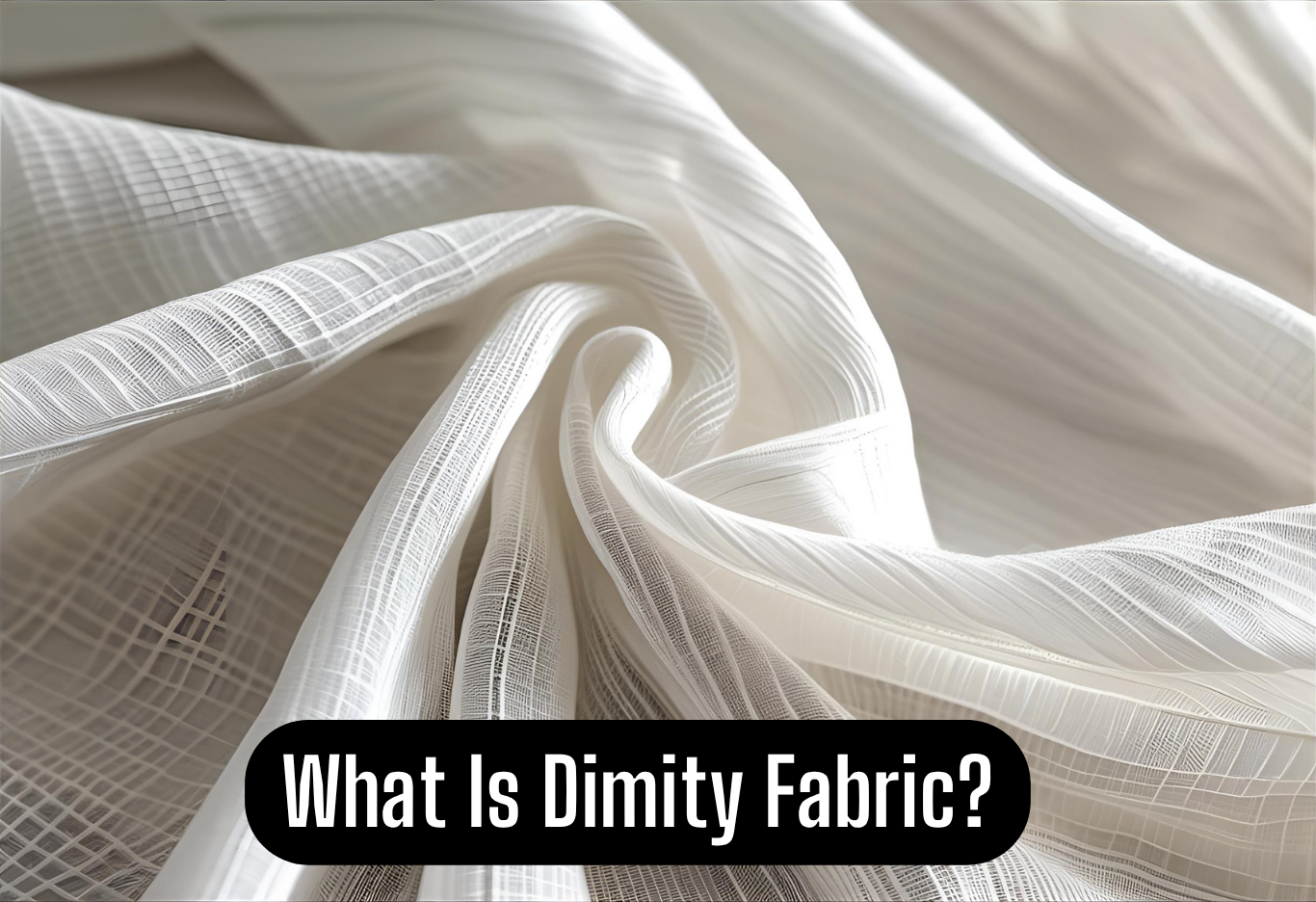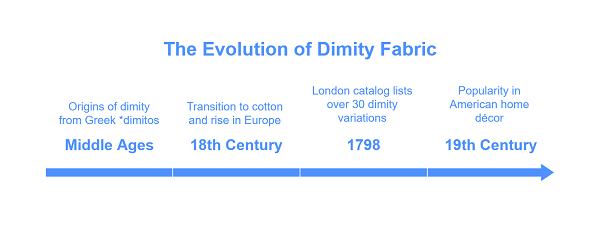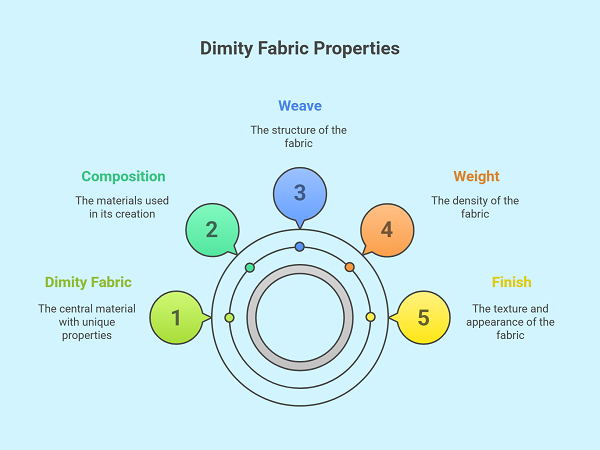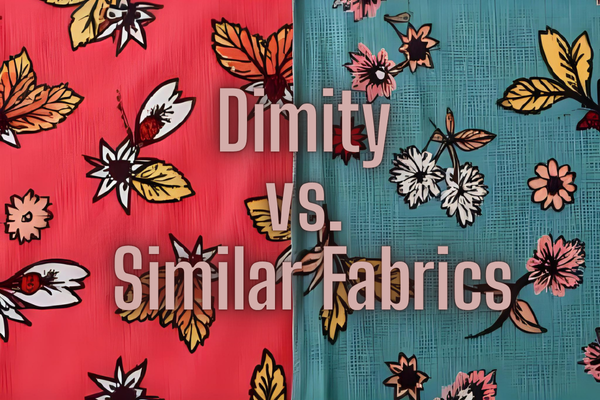What Is Dimity Fabric?
Dimity fabric. It sounds dainty, doesn’t it? But don’t let the name fool you. This textile may seem delicate, but it’s tougher than it looks. Woven from cotton or linen, dimity has been used for centuries—yes, centuries—to make everything from curtains to chemises. Its signature? Fine ribs or cords that run down the fabric, giving it both texture and structure.

Let’s be honest: not many people get excited about woven fabrics these days. But dimity isn’t just another weave. It’s breathable, structured, and oddly nostalgic. In a world full of synthetics, this cotton classic still holds its ground.
Table of Contents
Origins and History of Dimity Fabric

A Fabric Born in Antiquity
Dimity goes way back—some sources trace its use as far as the Middle Ages. Derived from the Greek dimitos (meaning “of two threads”), it originally referred to silk textiles. But by the 18th century, dimity transitioned to cotton and started gaining popularity in Europe.
Dimity in the 1700s and 1800s
Dimity fabric became a household staple. From Victorian nightgowns to elegant bed drapes, it was everywhere. A London textile merchant catalog from 1798 listed over 30 variations of dimity. That’s not random trivia—it shows just how embedded this fabric was in daily life.
The American Take
In the United States, dimity fabric found its place in home décor. It became the go-to for summer curtains—light, breezy, and machine-washable. That last one? A big deal in pre-dryer households.
Properties of Dimity Fabric

Composition and Structure
- Material: Usually 100% cotton, occasionally linen.
- Weave: Plain weave with warp ribs or cords.
- Weight: Ranges between 100–150 GSM (grams per square meter).
- Finish: Soft, sometimes glazed.
Dimity fabric isn’t slippery or stretchy. That’s its charm—it holds its shape, drapes softly, and doesn’t cling to your skin. Think of it like linen’s shy cousin with better manners.
Why It’s Still Relevant
- Breathable – Perfect for hot climates.
- Easy to dye – Holds colors like a pro.
- Textured – Adds subtle design without bold prints.
- Durable – Lasts wash after wash.
Modern Uses of Dimity Fabric

In Fashion
While not trending on TikTok, dimity fabric sneaks its way into niche clothing labels and vintage revivals. Some tailors swear by it for summer blouses, skirts, and nightwear. It’s crisp but never stiff—kind of like your favorite high school teacher.
Home Textiles
- Curtains – Especially in country-style or vintage interiors.
- Pillowcases – The textured weave makes them look more expensive than they are.
- Aprons – Durable, machine washable, and charming.
Special Mentions
You’ll find dimity fabric in historical costume recreation groups. Museums use it to replicate authentic garments from the 1700s. If that doesn’t scream staying power, what does?
How to Care for Dimity Fabric
Washing Tips
- Machine Wash: Cold or warm cycle.
- Drying: Air dry or low heat to prevent shrinking.
- Ironing: Use medium heat; it smooths out beautifully.
Stain Removal
Treat like standard cotton. Avoid bleach unless it’s white dimity. A mix of vinegar and baking soda usually does the trick for most stains.
Dimity vs. Similar Fabrics

Dimity vs. Muslin
Muslin is lighter, less textured, and more sheer. Dimity has that ribbed character and holds its form better.
Dimity vs. Cambric
Cambric is smoother and denser. Dimity feels airier—like it wants to float.
Dimity vs. Lawn
Lawn is polished and soft. Dimity has more grip and grain, with that signature corded effect.
Is Dimity Fabric Sustainable?
You bet. Most dimity is made from 100% cotton—biodegradable and renewable. If sourced from organic cotton, it ticks all the green boxes. It doesn’t require harsh chemical finishes, which makes it safer for sensitive skin and better for the planet.
Did you know that cotton garments like dimity can decompose in soil in just 5 months? Compare that to polyester, which takes over 200 years. Yep—dimity wins the eco-race hands down.
Final Thoughts on Dimity Fabric
Let’s wrap it up. Dimity fabric might not trend on Instagram, but it doesn’t need to. It’s functional, breathable, historic, and—dare we say—charming. Whether you’re sewing a vintage dress, redecorating your kitchen, or just nerding out about textiles, dimity deserves a spot on your radar.
You don’t need a PhD in fabric science to appreciate dimity. Just touch it, wear it, wash it—feel the difference. And next time someone asks, “What’s dimity fabric?” you’ll have more than enough to say.
FAQs About Dimity Fabric
Q1: Is dimity fabric good for summer?
Yes, it’s breathable, lightweight, and absorbs moisture—perfect for warm climates.
Q2: Can I use dimity for upholstery?
Not recommended. It’s too light. Try canvas or twill instead.
Q3: Is dimity always made of cotton?
Mostly, yes. But some vintage or specialty dimity may contain linen.
Q4: How do I know if a fabric is dimity?
Look for the textured, corded vertical lines. It also feels soft but structured.
Q5: Does dimity shrink after washing?
If it’s not pre-shrunk, yes. Always wash a test swatch or use cold water and air dry.
